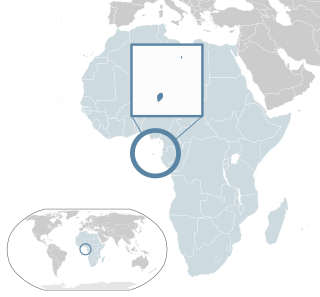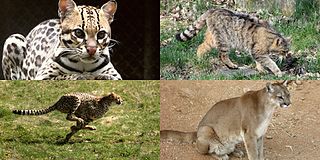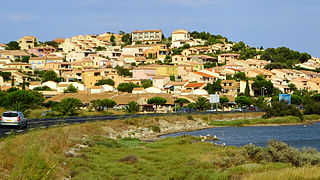Related Research Articles

The metre or meter is the base unit of length in the International System of Units (SI). The SI unit symbol is m.

Charles's law is an experimental gas law that describes how gases tend to expand when heated. A modern statement of Charles's law is:
When the pressure on a sample of a dry gas is held constant, the Kelvin temperature and the volume will be in direct proportion.

A mongoose is a small terrestrial carnivorous mammal belonging to the family Herpestidae. This family is currently split into two subfamilies, the Herpestinae and the Mungotinae. The Herpestinae comprises 23 living species that are native to southern Europe, Africa and Asia, whereas the Mungotinae comprises 11 species native to Africa. The Herpestidae originated about 21.8 ± 3.6 million years ago in the Early Miocene and genetically diverged into two main genetic lineages between 19.1 and 18.5 ± 3.5 million years ago.
Avogadro's law or Avogadro-Ampère's hypothesis is an experimental gas law relating the volume of a gas to the amount of substance of gas present. The law is a specific case of the ideal gas law. A modern statement is:
Avogadro's law states that "equal volumes of all gases, at the same temperature and pressure, have the same number of molecules."
For a given mass of an ideal gas, the volume and amount (moles) of the gas are directly proportional if the temperature and pressure are constant.

Felis is a genus of small and medium-sized cat species native to most of Africa and south of 60° latitude in Europe and Asia to Indochina. The genus includes the domestic cat. The smallest Felis species is the black-footed cat with a head and body length from 38 to 42 cm. The largest is the jungle cat with a head and body length from 62 to 76 cm.
Protoplasm is the living part of a cell that is surrounded by a plasma membrane.

Sarcophagidae are a family of flies commonly known as flesh flies. They differ from most flies in that they are ovoviviparous, opportunistically depositing hatched or hatching maggots instead of eggs on carrion, dung, decaying material, or open wounds of mammals, hence their common name. Some flesh fly larvae are internal parasites of other insects such as Orthoptera, and some, in particular the Miltogramminae, are kleptoparasites of solitary Hymenoptera. The adults mostly feed on fluids from animal bodies, nectar, sweet foods, fluids from animal waste and other organic substances. Juveniles need protein to develop and may be laid on carrion, dung or sweet plant foods.

Principense Creole, also called by its native speakers as lunguyê creole, is a Portuguese creole language spoken by a community of some four thousand people in São Tomé and Príncipe, specifically on the island of Príncipe. There are two Portuguese creoles on the island of São Tomé, Angolar and Forro. Today, younger generations of São Toméans are not likely to speak Principense, which has led to its fast decline and moribund status. It is mostly spoken by the elderly, while most of the island's community speaks noncreole Portuguese; some also speak another, closely related creole, Forro.
The Bolgo language is a member of the Bua languages spoken in south-central Chad, in the villages of Koya, Boli, Gagne, and Bedi southeast of Melfi, by about 1,800 people. Speakers also make up the majority of the population of Sorki canton in Chinguil sub-prefecture.

The Felinae are a subfamily of the family Felidae. This subfamily comprises the small cats having a bony hyoid, because of which they are able to purr but not roar.

Gallo-Roman religion is a fusion of the traditional religious practices of the Gauls, who were originally Celtic speakers, and the Roman and Hellenistic religions introduced to the region under Roman Imperial rule. It was the result of selective acculturation.

Leucate is a commune in the Aude department in southern France. It lies between the Mediterranean Sea and the lagoon Étang de Leucate.

Samoreau is a commune in the Seine-et-Marne department in the Île-de-France region in north-central France.

Pel-et-Der is a commune in the Aube department in north-central France.

Muhlbach-sur-Bruche is a commune in the Bas-Rhin department in Grand Est in north-eastern France.

The Micoquien is an early middle paleolithic industry, that is found in the Eemian and in an early episode of the Würm glaciation. The Micoquien is distinguished technologically by the appearance of distinctly asymmetrical bifaces. Its discoverer and namer was the archeologist and art trader Otto Hauser. Hauser then sold a great number of so-called Micoque-wedges that he found in excavations in La Micoque to museums and collectors.
The Dassareti were an Illyrian people that lived in the inlands of southern Illyria, between present-day south-eastern Albania and south-western North Macedonia. Their territory included the entire region between the rivers Asamus and Eordaicus, the plateau of Korça locked by the fortress of Pelion and, towards the north it extended to Lake Lychnidus up to the Black Drin. They were directly in contact with the regions of Orestis and Lynkestis of Upper Macedonia. Their chief city was Lychnidos, located on the edge of the lake of the same name.
The Indo-Semitic hypothesis maintains that a genetic relationship exists between Indo-European and Semitic and that the Indo-European and the Semitic language families descend from a prehistoric language ancestral to them both. The theory has never been widely accepted by contemporary linguists in modern times, but historically it has had a number of supporting advocates and arguments, particularly in the 19th and 20th centuries.

Human rights in Senegal are generally better respected than in other countries in the continent, but cases of violation are still regularly reported.
References
- ↑ Genera des Coléoptère d'Europe comprenant leur classification en famille naturelle, la description de les genres, des Tableaux dichotomiques destinés à faciliter l'Etude, le Catalogue de toutes les espèces, de nombreux dessins au trait de caractères. C Jacquelin du Val T, 1854.
- Reitter, E. 1908: Übersicht der mir bekannten Arten der Curculioniden-Üntergattung Chaerodrys Duv. Entomologische Blätter 4: 32–34.